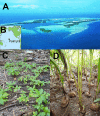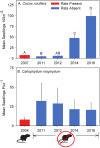Invasive rat eradication strongly impacts plant recruitment on a tropical atoll
- PMID: 30016347
- PMCID: PMC6049951
- DOI: 10.1371/journal.pone.0200743
Invasive rat eradication strongly impacts plant recruitment on a tropical atoll
Abstract
Rat eradication has become a common conservation intervention in island ecosystems and its effectiveness in protecting native vertebrates is increasingly well documented. Yet, the impacts of rat eradication on plant communities remain poorly understood. Here we compare native and non-native tree and palm seedling abundance before and after eradication of invasive rats (Rattus rattus) from Palmyra Atoll, Line Islands, Central Pacific Ocean. Overall, seedling recruitment increased for five of the six native trees species examined. While pre-eradication monitoring found no seedlings of Pisonia grandis, a dominant tree species that is important throughout the Pacific region, post-eradication monitoring documented a notable recruitment event immediately following eradication, with up to 688 individual P. grandis seedlings per 100m2 recorded one month post-eradication. Two other locally rare native trees with no observed recruitment in pre-eradication surveys had recruitment post-rat eradication. However, we also found, by five years post-eradication, a 13-fold increase in recruitment of the naturalized and range-expanding coconut palm Cocos nucifera. Our results emphasize the strong effects that a rat eradication can have on tree recruitment with expected long-term effects on canopy composition. Rat eradication released non-native C. nucifera, likely with long-term implications for community composition, potentially necessitating future management interventions. Eradication, nevertheless, greatly benefitted recruitment of native tree species. If this pattern persists over time, we expect long-term benefits for flora and fauna dependent on these native species.
Conflict of interest statement
The authors have declared that no competing interests exist. Hillary Young and Rodolfo Dirzo received funding to support (2007) field work at Palmyra Atoll by the commercial funder, National Geographic. HY and RD do not have any financial or non-financial competing interests as a result of this award. This does not alter our adherence to PLOS ONE policies on sharing data and materials.
Figures





References
-
- Atkinson IAE. The spread of commensal species of Rattus to oceanic islands and their effects on island avifaunas In: Moors PJ, editor. Conservation of Island Birds. New Zealand: Department of Scientific and Industrial Research; 1985. p. 35–81.
-
- Towns DR, Atkinson IAE, Daugherty CH. Have the harmful effects of introduced rats on islands been exaggerated? Biol Invasions. 2006;8(4): 863–91.
Publication types
MeSH terms
Associated data
LinkOut - more resources
Full Text Sources
Other Literature Sources

